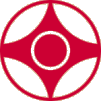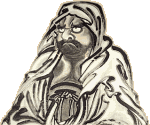

 Kyokushinkai
Kyokushinkai
The kanji
(Japanese characters) calligraphy, worn universally on the front of the gi, simply means
"Kyokushinkai", which is the name given by Sosai Mas Oyama to the karate
style he created. It is composed of three characters:
Kanku
 The symbol of Kyokushin Karate is the Kanku,
which is derived from Kanku Kata, the Sky Gazing Form. In this kata, the hands
are raised and the fingers meet to form an opening through which the sky is
viewed. The top and bottom points of the Kanku represent the first
fingers of each hand touching at the top and the thumbs touching at the bottom,
symbolizing the peaks or ultimate points. The thick sections at the sides
represent the wrists, symbolizing power. The center circle represents the opening
between the hands through which the sky is viewed, symbolizing infinite depth.
The whole Kanku is enclosed by a circle, symbolizing continuity and circular
action.
The symbol of Kyokushin Karate is the Kanku,
which is derived from Kanku Kata, the Sky Gazing Form. In this kata, the hands
are raised and the fingers meet to form an opening through which the sky is
viewed. The top and bottom points of the Kanku represent the first
fingers of each hand touching at the top and the thumbs touching at the bottom,
symbolizing the peaks or ultimate points. The thick sections at the sides
represent the wrists, symbolizing power. The center circle represents the opening
between the hands through which the sky is viewed, symbolizing infinite depth.
The whole Kanku is enclosed by a circle, symbolizing continuity and circular
action.
Budo Karate
What is Kyokushin karate?
To some, it is a way to develop and maintain physical strength and learn effective self-defense techniques. To others, it is much more than that.
Kyokushin karate is a way of life that transcends the aspects of training. Kyokushin karate is Budo Karate.
The essence of budo karate cannot readily be depicted in a few paragraphs. However, one can get a glimpse of its meaning by looking at the origin of the martial arts and its relationship
with Eastern philosophies, and by examining the words "Karate" and
"Budo" themselves.
Kyokushin karate, like most martial arts, can trace its
origin to Bodhidharma (Daruma in Japanese), an Indian prince and Buddhist priest
who traveled to the Shaolin temple in China in the early sixth century.
There, he developed the Chan, or "Intuitive" school of Mahayana
Buddhism. Under the
Chan philosophy, enlightenment was sought through meditation, rather
than by the practice of rituals or the study of religious texts. According
to legend, Bodhidharma sat facing the wall in the Shaolin temple for nine years,
until he achieved enlightenment. (Other legends have him sitting and
facing a wall in a cave for nine years.) Bodhidharma also developed
martial arts as a physical regimen to accompany the mental discipline of the
meditation. During the following centuries, the Chan (or Zen
in Japanese) philosophy spread to Okinawa and then to Japan, accompanied with
martial arts. Over time, Zen and martial arts became intermingled
with each other and deeply ingrained in Japanese society.
The word Karate is derived from the words:
![]() Kara meaning
"Empty",
Kara meaning
"Empty",
and
![]() Te meaning
"Hand".
Te meaning
"Hand".
Kara also means "Chinese", and the original meaning of the word karate
was "Chinese Hand" because of its origins in Chinese kempo.
However, Gichin Funakoshi, the Okinawan master who brought karate to Japan and
developed Shotokan karate (one of the styles from which Kyokushin was derived),
believed that "empty" better described the meaning of karate:
The Kara that means "empty" is definitely the more appropriate. For one thing, it
symbolizes the obvious fact that this art of self-defense makes use of no
weapons, only bare feet and empty hands. Further, students of Karate-do
aim not only toward perfecting their chosen art but also toward emptying heart
and mind of all earthly desire and vanity. Reading Buddhist scriptures, we
come across such statements as "Shiki soku ze ku" and "Ku soku zeshiki,"
which literally mean "Matter is void" and "All is vanity."
The character Ku, which appears in both admonitions and may be pronounced Kara,
is in itself truth.
The word Budo is derived from the words:
![]() Bu meaning "Martial" or "Combat",
Bu meaning "Martial" or "Combat",
and
![]() Do meaning "Way" or "Path".
Do meaning "Way" or "Path".
Budo, the Martial Way, is a Japanese term for arts that use peaceful combat as a means of perfecting the self. The word Do comes from the Chinese word Tao and the philosophy of Taoism. Do does not mean the "way" or method of learning something, such as the learning the techniques of karate, but rather it is the path of life whereby what is learned is transcended into
wisdom.
Do and Zen are complementary. Zen seeks self-perfection through passive means, such as meditation. Do
seeks self-perfection through active means, such as the training itself.
In fact, the practice of kata is sometimes referred to as Dozen, or
"Moving Meditation". That which is gained through Budo
is much more than just the techniques and applications of the martial arts, and
it transforms all aspects of life.
Karate and Budo are sometimes
combined as Karatedo, or the "Empty Hand Way".
 The word Dojo, or training
hall, literally means the "Way Place", and it is also the name of the
room used for meditation in a Buddhist temple. A karate dojo is not a gym,
even though the training is physically demanding and a lot of sweat is shed in a
Kyokushin dojo. It is a sacred a place of learning, and as such, it is
treated with respect. Karateka (karate practitioners) bow before
entering or leaving the dojo. Shoes are not worn in the dojo not only to
keep the dojo clean, but to keep the "outside world" out. Mokuso
(meditation) is sometimes done before training to clear the mind and depart
from the "outside world", and after training to clear the mind again
in order to return to the "outside world".
The word Dojo, or training
hall, literally means the "Way Place", and it is also the name of the
room used for meditation in a Buddhist temple. A karate dojo is not a gym,
even though the training is physically demanding and a lot of sweat is shed in a
Kyokushin dojo. It is a sacred a place of learning, and as such, it is
treated with respect. Karateka (karate practitioners) bow before
entering or leaving the dojo. Shoes are not worn in the dojo not only to
keep the dojo clean, but to keep the "outside world" out. Mokuso
(meditation) is sometimes done before training to clear the mind and depart
from the "outside world", and after training to clear the mind again
in order to return to the "outside world".
A karate uniform is called a Dogi (or Gi for
short), and the word literally means "Way Clothes". Just as a
dojo is not a gym, a karate
dogi is not just clothes in which to train. A dogi is what
a
karateka wears on the path toward self-perfection. It should
always be kept clean and in good repair. According to Mas Oyama, "to
repair a torn uniform is no disgrace, but to wear a torn or dirty one
is." However, the
obi (belt) should never be washed. Over time, it becomes frayed
and stained with the sweat and blood of hard training. An old, worn and
stained
obi reflects the karateka's unique experience of training, which
should not be washed away.
Mas Oyama fully understood the
nature of Kyokushin Karate as budo karate, a path toward self-perfection though
the practice of the martial art:
Karate is the most Zen-like of all the Martial Arts. It has abandoned the sword. This means that it transcends the idea of winning and losing to become a way of thinking and living for the sake of other people in accordance with the way of Heaven. Its meanings, therefore, reach the profoundest levels of human thought.
For a long time, I have emphasized that karate is budo, and if the budo is removed from karate, it is nothing more than sport karate, show karate or even fashion karate â the idea of training merely to be fashionable.
Karate that has discarded budo has no substance. It is nothing more than a barbaric method of fighting or a promotional tool for the purpose of profit. No matter how popular it becomes, it is meaningless.
The philosophy of budo is evident
in the name that Mas Oyama chose for his karate style, Kyokushin, which
means "UltimateTruth". It is also reflected in the Dojo Kun, in
Mas Oyama's Eleven Mottos, and in the Spirit of Osu.
Dojo Kun 
The Kyokushin Dojo Kun
(Training Hall Oath) was written by Mas Oyama with the help of Eiji Yoshikawa,
the author of the novel Musashi, which was based on the life and exploits
of Miyamoto Musashi, Japan's most famous Samurai warrior.
The Dojo Kun is usually recited at the end of each training session, when the students and instructors are lined up by rank in seiza (formal kneeling). Each line of the Dojo Kun is recited by the most senior student and repeated by the entire class together. Some dojos choose not to recite the Dojo Kun for various reasons.
Dojo Kun
1. We will train our hearts and bodies,For a firm unshaking spirit.
2. We will pursue the true meaning of the Martial Way,So that in time our senses may be alert.
3. With true vigor,We will seek to cultivate a spirit of self denial.
4. We will observe the rules of courtesy,Respect our superiors, and refrain from violence.
5. We will follow our God, And never forget the true virtue of humility.
6. We will look upwards to wisdom and strength, Not seeking other desires.
7. All our lives, through the discipline of Karate, We will seek to fulfill the true meaning of the Kyokushin Way.
Some dojos recite the fifth line as "We will follow our Gods and Buddha...", which is a more literal translation of shinbutsu. However, the full meaning of the Japanese word is not expressed in this literal translation, since it involves Buddhist and Shinto principles with which many Westerners are not familiar. Other dojos recite the line as "We will follow our religious principles..."
Eleven Mottos 
Mas
Oyama summed up his entire martial arts philosophy in eleven mottos, known as
the Zayu no Mei Juichi Kajo, which are central to his teaching:
Zayu no Mei Juichi Kajo
1. The Martial Way begins and ends with courtesy. Therefore, be properly and genuinely courteous at all times.
2. Following the Martial Way is like scaling a cliff â continue upwards without rest. It demands absolute and unfaltering devotion to the task at hand.
3. Strive to seize the initiative in all things, all the time guarding against actions stemming from selfish animosity or thoughtlessness.
4. Even for the Martial Artist, the place of money cannot be ignored. Yet one should be careful never to become attached to it.
5. The Martial Way is centered in posture. Strive to maintain correct posture at all times.
6. The Martial Way begins with one thousand days and is mastered after ten thousand days of training.
7. In the Martial Arts, introspection begets wisdom. Always see contemplation on your actions as an opportunity to improve.
8. The nature and purpose of the Martial Way is universal. All selfish desires should be roasted in the tempering fires of hard training.
9. The Martial Arts begin with a point and end in a circle. Straight lines stem from this principle.
10. The true essence of the Martial Way can only be realized through experience. Knowing this, learn never to fear its demands.
11. Always remember, in the Martial Arts, the rewards of a confident and grateful heart are truly abundant.
The Spirit of Osu 
Osu is the one word that you'll hear the most in a Kyokushin dojo or at a Kyokushin tournament. When you enter or leave the dojo, you bow and say "Osu". When you greet a fellow Kyokushin karateka, you say "Osu" instead of "hello". When you respond to an instruction or question in class, you say "Osu" instead of "yes" or "I understand". When performing kihon waza (basic techniques) in class, each technique is often accompanied with a loud "Osu". When practicing jiyu kumite (free fighting) in class and your opponent lands a good, hard technique, you say "Osu" to acknowledge your opponent's skill. As a measure of respect, knockdown fighters at a tournament bow and say "Osu" to the front, to the referee and to each other, before and after the fight. Osu is used in many situations and seems to mean a lot of things. But what does it really
mean?
Osu is a contraction of the
words:
![]() Oshi
meaning "Push",
Oshi
meaning "Push",
and
![]() Shinobu
meaning "to Endure".
Shinobu
meaning "to Endure".
It means patience, determination and perseverance.
Every time we say "Osu", we remind ourselves of this. Kyokushin training is very demanding. You push yourself until you think you've reached your limit. First your body wants to stop, but your mind keeps pushing you. Then your mind wants to stop, but your spirit keeps you going. You endure the pain. You persevere. That is Osu.
Kyokushin karate is not learned overnight. It takes years to properly learn the fundamentals. The basic techniques are performed thousands of times (ren ma â "alwayspolishing") until they are done by reflex or instinct, without conscious thought (mushin â "no mind"). It's easy to get frustrated by doing the same thing over and over again, especially when progress seems to be slow. To overcome that frustration and continue training takes patience and determination. That is Osu.
The absolute and unfaltering devotion needed to "scale the cliff" of Kyokushin karate is Osu.
The spirit of Osu is probably best described by Shihan Cameron Quinn of Australia in his book The Budo Karate of Mas Oyama.
He writes:
There is a saying in Japan, "Ishi no ue ni sannen." Translated, it means "Three years on a rock." This saying symbolizes the need to persevere at all times. It is one of the most important philosophies in Kyokushin karate.Kyokushin is an art offering many things according to the immediate and long term aims of the trainee. Ultimately, one realizes that transcending the kicks, the punches, and the kata, there is a special spirit in the heart of the participants. It teaches them to face the demands of daily life with a mature and enduring attitude. A budo-ka is not easily shaken by the blows of adversity, realizing that for a person to draw near to their true potential, a never-say-die spirit of perseverance is required.
This strength of character develops in hard training and is known as osu no seishin (the spirit of Osu). The word Osu comes from oshi shinobu, which means "to persevere whilst being pushed". It implies a willingness to push oneself to the limits of endurance, to persevere under any kind of pressure.
The single word Osu captures most accurately the ultimate in what the art of karate, particularly Kyokushin, has to offer. One who is truly able to manifest the spirit of Osu in every word, thought, and action may be regarded as wise and brave. Training should first and foremost be approached in the spirit of Osu. One's daily life, and the responsibilities it holds, would be more completely lived if addressed in the spirit of Osu.
Even for the beginner, who is conscious of his lack of training and does not necessarily want to face the demand of training, it is enough merely being aware that through perseverance and the will to continue, there comes great physical, mental, spiritual, and emotional gains. All that is needed is that special determination.
In other words, Osu.
